Urban Rivers Corridors in the Don Catchment, UK: From Ignored, Ignoble and Industrial to Green, Seen and Celebrated
Abstract
:1. Introduction
2. Catchment Overview
“Commonly every May such vast numbers of young eels comes over the wheels with the waters and run into the mills, that they are forced to give over working and to send into town for the swine to devour them, for they are as innumerable as sand grains on the seashore”.[16]
3. Phase 1—Industrialisation, Urbanisation, Ecological Devastation, and Disconnection of Rivers from People
“Formerly its filthy and turbid waters flowed uncovered close to the main street, which circumstance gave strangers a very disagreeable impression of the town. Before the water reaches the town it is perfectly clear, but during its further course, dye-houses, calenders, and sewers complete its defilement”.[22]
“The three rivers sluggishly flowing through the town are made the conduits of all imaginable filth, and at one particular spot which we shall presently describe, positively run blood. These rivers, that should water Sheffield so pleasantly, are polluted with dirt, dust, dung, and carrion; the embankments are ragged and ruined; here and there overhung with privies; and often the site of ash and offal heaps—most desolate and sickening objects … A plank bridge over the Sheaf here shows dead dogs and cats floating on the slimy waters, and a terrible condition of the partially-walled banks, through outlets in which fluents of excremental slush ooze into the river. It is 26 feet wide at this point, and has all the appearance of having once been a vast covered sewer, and having now become ruined, it being impossible to realize that the objects in it were ever intended to meet the sight or smell”.[23]
4. Phase 2—Deindustrialisation, Partial Ecological Recovery
5. Improving the Don Catchment’s Urban Rivers for the Environment and for People
5.1. Restoration of Ecological Connectivity through the River Network
5.2. Natural Flood Management
5.3. Reconnecting the Public with Rivers
“…rivers make cities and it is a marvellous facility waiting to be developed”
“I think [the river] is a little gem for our town and it needs to be brought out to flourish and become a focal point of the town and the wider region”.
- To inspire and mobilise the community
- To foster understanding and change perceptions
“Now I know more about the heritage of the River Don I feel I have a much deeper understanding and even a connection with the river”.
“Volunteering has made me feel connected to and proud of the place in which I live”
“[It motivates me to see] the value volunteering brings to the local community”
“Thanks for the incredible work you are doing to make Chesterfield a better place for the river life and for us humans”.
6. Discussion
7. Conclusions
Author Contributions
Funding
Institutional Review Board Statement
Informed Consent Statement
Data Availability Statement
Conflicts of Interest
References
- Hanna, D.E.L.; Tomscha, S.A.; Dallaire, C.O.; Bennett, E.M. A Review of Riverine Ecosystem Service Quantification: Research Gaps and Recommendations. J. Appl. Ecol. 2018, 55, 1299–1311. [Google Scholar] [CrossRef]
- Lerner, D.N.; Holt, A. How Should We Manage Urban River Corridors? Procedia Environ. Sci. 2012, 13, 721–729. [Google Scholar] [CrossRef] [Green Version]
- Francis, R.A. Urban Rivers: Novel Ecosystems, New Challenges. WIREs Water 2014, 1, 19–29. [Google Scholar] [CrossRef]
- Everard, M.; Moggridge, H.L. Rediscovering the Value of Urban Rivers. Urban Ecosyst Urban Ecosyst. 2012, 15, 293–314. [Google Scholar] [CrossRef]
- Booth, D.B.; Roy, A.H.; Smith, B.; Capps, K.A. Global Perspectives on the Urban Stream Syndrome. Freshw. Sci. 2016, 35, 412–420. [Google Scholar] [CrossRef] [Green Version]
- Walsh, C.J.; Roy, A.H.; Feminella, J.W.; Cottingham, P.D.; Groffman, P.M.; Morgan, R.P. The Urban Stream Syndrome: Current Knowledge and the Search for a Cure. J. N. Am. Benthol. Soc. 2005, 24, 706–723. [Google Scholar] [CrossRef]
- Meyer, J.L.; Paul, M.J.; Taulbee, W.K. Stream Ecosystem Function in Urbanizing Landscapes. J. N. Am. Benthol. Soc. 2005, 24, 602–612. [Google Scholar] [CrossRef]
- Paetzold, A.; Warren, P.H.; Maltby, L.L. A Framework for Assessing Ecological Quality Based on Ecosystem Services. Ecol. Complex. 2010, 7, 273–281. [Google Scholar] [CrossRef]
- Raven, P.; Holmes, N. Rivers: A Natural and Not-So-Natural History; Bloomsbury Publishing PLC: London, UK, 2014; ISBN 9780956490254. [Google Scholar]
- Morton, R.; Rowland, C.; Wood, C.; Meek, L.; Marston, C.; Smith, G. Land Cover Map 2007. NERC Environmental Information Data Centre. 2014. Available online: https://doi.org/10.5285/a1f88807-4826-44bc-994d-a902da5119c2 (accessed on 26 May 2021).
- Office for National Statistics 2011 Census: Digitised Boundary Data (England and Wales). UK Data Service Census Support. Available online: https://borders.ukdataservice.ac.uk/ (accessed on 26 May 2021).
- Rotherham, I.D. The Impacts of Recolonisation of an Urbanised River by Native and Non-Native Species. Front. Ecol. Evol. 2021, 9, 618371. [Google Scholar] [CrossRef]
- Marchant, J.; Ratcliffe, D.; Lines, A.; Saich, D. South Yorkshire Historic Environment Characterisation; South Yorkshire Archaeology Service: Sheffield, UK, 2008. [Google Scholar]
- Firth, C.J. Domesday to the Dawn of the New Millennium: 900 Years of the Don Fishery; Environment Agency: Rotherham, UK, 1997. [Google Scholar]
- Jacoby, D.; Gollock, M. Anguilla Anguilla: The IUCN Red List of Threatened Species 2014: e.T60344A152845178. 2020. Available online: https://www.researchgate.net/publication/225502406_Linking_plant_morphological_traits_to_uprooting_resistance_in_eroded_marly_lands_Southern_Alps_France (accessed on 25 May 2021).
- De la Pryme, A.; Jackson, C. The Diary of Abraham de La Pryme, the Yorkshire Antiquary; The Surtees Society: Ripon, UK, 1870. [Google Scholar]
- Palmer, J.; Powell-Smith, A. Open Domesday. 2020. Available online: https://opendomesday.org/ (accessed on 1 May 2021).
- Hey, D. The South Yorkshire Steel Industry and the Industrial Revolution. North. Hist. 2005, 42, 91–96. [Google Scholar] [CrossRef]
- Wray, N.; Hawkins, B.; Giles, C.; Rodgers, R.; Trainor, V. One Great Workshop: The Buildings of the Sheffield Metal Trades; English Heritage: London, UK, 2001; ISBN 978-1-873592-66-3. [Google Scholar]
- Shaw, E.A. Weir Management: Challenges, Analysis and Decision Support; Catchment Science Centre, Department of Civil and Structural Engineering, The University of Sheffield: Sheffield, UK, 2012. [Google Scholar]
- Fullerton, A.H.; Burnett, K.M.; Steel, E.A.; Flitcroft, R.L.; Pess, G.R.; Feist, B.E.; Torgersen, C.E.; Miller, D.J.; Sanderson, B.L. Hydrological Connectivity for Riverine Fish: Measurement Challenges and Research Opportunities. Freshw. Biol. 2010, 55, 2215–2237. [Google Scholar] [CrossRef] [Green Version]
- Jackson, R. The History of the Town and Township of Barnsley, in Yorkshire, 2nd ed.; Bell & Daldy: London, UK, 1858. [Google Scholar]
- A Report on the Condition of Our Chief Towns-Sheffield. Builder. 1861. Available online: https://onlinebooks.library.upenn.edu/webbin/serial?id=builder (accessed on 1 May 2021).
- South Yorkshire Archaeology Service South Yorkshire Historic Environment Characterisation Project. 2013. Available online: https://doi.org/10.5284/1019858 (accessed on 1 May 2021).
- Lunn, K.; Lewis, J.; Lord, J.; Marchant, J.; Thomas, C. West Yorkshire Historic Environment Characterisation Project. 2017. Available online: https://doi.org/10.5284/1042125 (accessed on 1 May 2021).
- Derbyshire County Council Derbyshire Historic Landscape Characterisation Project [Data-Set]. 2016. Available online: https://doi.org/10.5284/1039452 (accessed on 1 May 2021).
- Broadhead, A.T.; Horn, R.; Lerner, D.N. Finding Lost Streams and Springs Captured in Combined Sewers: A Multiple Lines of Evidence Approach: Finding Captured Streams and Springs. Water Environ. J. 2015, 29, 288–297. [Google Scholar] [CrossRef]
- European Commission Directive. 2000/60/EC of the European Parliament and of the Council of 23rd October 2000 Establishing a Framework for Community Action in the Field of Water Policy. In Official Journal of the European Communities, L327/1; European Commission: Brussels, Belgium, 2000. [Google Scholar]
- Ordnance Survey OS 25 Inch England and Wales, 1841–1952; Yorkshire CCLXXXIII.3; Ordnance Survey: Yorkshire, UK, 1930.
- Digaetano, A.; Lawless, P. Urban Governance and Industrial Decline: Governing Structures and Policy Agendas in Birmingham and Sheffield, England, and Detroit, Michigan, 1980–1997. Urban Aff. Rev. 1999, 34, 546–577. [Google Scholar] [CrossRef]
- Maltby, L.; Paetzold, A.; Warren, P. Sustaining industrial activity and ecological quality: The potential role of an ecosystem services approach. In Ecology of Industrial Pollution; Batty, L.C., Hallberg, K.B., Eds.; Cambridge University Press: Cambridge, UK, 2010; pp. 327–344. ISBN 978-0-511-80556-1. [Google Scholar]
- Kumar, V.; Rouquette, J.R.; Lerner, D.N. Integrated Modelling for Sustainability Appraisal of Urban River Corridors: Going beyond Compartmentalised Thinking. Water Res. 2013, 47, 7221–7234. [Google Scholar] [CrossRef] [PubMed] [Green Version]
- Don, Dearne & Rother Network. Catchment Plan for the Don and Rother Catchment 2021–2026; Don, Dearne & Rother Network: Doncaster, UK, 2021. [Google Scholar]
- Wild, T.C.; Dempsey, N.; Broadhead, A.T. Volunteered Information on Nature-Based Solutions—Dredging for Data on Deculverting. Urban For. Urban Green. 2019, 40, 254–263. [Google Scholar] [CrossRef]
- Leunda, P.M.; Ardaiz, J.; Russell, I.C.; Toms, S.; Hillman, R. Homing and Straying of Atlantic Salmon in the Bidasoa River: Report of an Unusual Stray from Great Britain to the Iberian Peninsula. Fish Manag. Ecol. 2013, 20, 460–463. [Google Scholar] [CrossRef]
- Kurlansky, M.; Lichatowich, J.; Gayeski, N. Salmon: A Fish, the Earth, and the History of Their Common Fate; Patagonia: Ventura, CA, USA, 2020; ISBN 1-938340-86-88. [Google Scholar]
- Birnie-Gauvin, K.; Thorstad, E.B.; Aarestrup, K. Overlooked Aspects of the Salmo salar and Salmo trutta Lifecycles. Rev. Fish Biol. Fish. 2019, 29, 749–766. [Google Scholar] [CrossRef]
- Bunt, C.M.; Castro-Santos, T.; Haro, A. Performance of Fish Passage Structures at Upstream Barriers To Migration. River Res. Applic. 2012, 28, 457–478. [Google Scholar] [CrossRef]
- Noonan, M.J.; Grant, J.W.A.; Jackson, C.D. A Quantitative Assessment of Fish Passage Efficiency: Effectiveness of Fish Passage Facilities. Fish Fish. 2012, 13, 450–464. [Google Scholar] [CrossRef]
- Kemp, P.S.; O’Hanley, J.R. Procedures for Evaluating and Prioritising the Removal of Fish Passage Barriers: A Synthesis. Fish. Manag. Ecol. 2010. [Google Scholar] [CrossRef]
- Environment Agency. Review of 2007 Summer Floods; Environment Agency: Bristol, UK, 2007. Available online: https://www.gov.uk/government/publications/summer-2007-floods-review (accessed on 1 May 2021).
- Parsons, R. Too Many People in Flood-Hit Doncaster Were without Insurance, Says Major Review by Aviva Chief Amanda Blanc. Yorkshire Post. 5 November 2020. Available online: https://www.yorkshirepost.co.uk/news/politics/too-many-people-flood-hit-doncaster-were-without-insurance-says-major-review-aviva-chief-amanda-blanc-3025532 (accessed on 1 May 2021).
- Blöschl, G.; Hall, J.; Viglione, A.; Perdigão, R.A.P.; Parajka, J.; Merz, B.; Lun, D.; Arheimer, B.; Aronica, G.T.; Bilibashi, A.; et al. Changing Climate Both Increases and Decreases European River Floods. Nature 2019, 573, 108–111. [Google Scholar] [CrossRef]
- RESTORE. Rivers by Design, Rethinking Development and River Restoration. A Guide Forplanners, Developers, Architects and Landscape Architects on Maximising the Benefits of River Restoration; Environment Agency: Bristol, UK, 2013. [Google Scholar]
- Environment Agency Event Duration Monitoring—Storm Overflows—2020. 2021. Available online: https://environment.data.gov.uk/dataset/21e15f12-0df8-4bfc-b763-45226c16a8ac (accessed on 15 May 2021).
- Burgess-Gamble, L.; Ngai, R.; Wilkinson, M.; Nisbet, T.; Pontee, N.; Harvey, R.; Kipling, K.; Addy, S.; Rose, S.; Maslen, S. Working with Natural Processes–Evidence Directory; Report No. SC150005; Environmental Agency: Bristol, UK, 2017. [Google Scholar]
- Twohig-Bennett, C.; Jones, A. The Health Benefits of the Great Outdoors: A Systematic Review and Meta-Analysis of Greenspace Exposure and Health Outcomes. Environ. Res. 2018, 166, 628–637. [Google Scholar] [CrossRef]
- Brown, S. The Social Benefits of Blue Space: A Systematic Review; Environment Agency: Bristol, UK, 2020. [Google Scholar]
- Murray, R.; Baldwin, J.; Ridgway, K.; Winder, B. Socio-Economic Decline and Adaptation: South Yorkshire’s Former Coalfields. Local Econ. 2005, 20, 344–359. [Google Scholar] [CrossRef]
- Noble, S.; McLennan, D.; Noble, M.; Plunkett, E.; Gutacker, N.; Silk, M.; Wright, G. The English Indices of Deprivation 2019; The British Government: London, UK, 2019. Available online: https://www.gov.uk/government/statistics/english-indices-of-deprivation-2019 (accessed on 15 May 2021).
- Marmot, M. Health Equity in England: The Marmot Review 10 Years On. BMJ 2020, m693. [Google Scholar] [CrossRef] [PubMed]
- Marmot, M. Fair Society, Healthy Lives: Strategic Review of Health Inequalities in England Post 2010; University College London: London, UK, 2013. [Google Scholar]
- Turnbull, P. Weirs on the River Loxley, Bradfield, Sheffield, South Yorkshire: Heritage Statement. A Report to the Don Catchment Rivers Trust; The Brigantia Archaeological Practice: Barnard Castle, UK, 2012. [Google Scholar]
- Shaw, E.A.; Lange, E.; Shucksmith, J.D.; Lerner, D.N. Importance of Partial Barriers and Temporal Variation in Flow When Modelling Connectivity in Fragmented River Systems. Ecol. Eng. 2016, 91, 515–528. [Google Scholar] [CrossRef] [Green Version]
- Armstrong, B.H. Marginal Landscapes, Apple iTunes. 2016. ISBN 978-0-9945673-0-7. Available online: https://www.researchgate.net/publication/309635130_Marginal_Landscapes (accessed on 15 May 2021).
- Selman, P.; Carter, C.; Lawrence, A.; Morgan, C. Re-Connecting with a Recovering River through Imaginative Engagement. Ecol. Soc. 2010, 15, 18. [Google Scholar] [CrossRef] [Green Version]
- Laville, S. Shocking State of English Rivers Revealed as all of Them Fail Pollution Tests. Guardian. Thursday. 17 September 2020. Available online: https://eastdevonwatch.org/2020/09/17/shocking-state-of-english-rivers-revealed-as-all-of-them-fail-pollution-tests/ (accessed on 15 May 2021).
- Corry, D. Where Are England’s Charities? Think NPC, London. January 2020. Available online: https://www.thinknpc.org/resource-hub/where-are-englands-charities/ (accessed on 15 May 2021).
- Mondy, C.P.; Villeneuve, B.; Archaimbault, V.; Usseglio-Polatera, P. A New Macroinvertebrate-Based Multimetric Index (I2M2) to Evaluate Ecological Quality of French Wadeable Streams Fulfilling the WFD Demands: A Taxonomical and Trait Approach. Ecol. Indic. 2012, 18, 452–467. [Google Scholar] [CrossRef]
- Pallottini, M.; Cappelletti, D.; Fabrizi, A.; Gaino, E.; Goretti, E.; Selvaggi, R.; Céréghino, R. Macroinvertebrate Functional Trait Responses to Chemical Pollution in Agricultural-Industrial Landscapes. River Res. Applic. 2017, 33, 505–513. [Google Scholar] [CrossRef]
- Tubridy, D. The Green Adaptation-Regeneration Nexus: Innovation or Business-as-Usual? Eur. Plan. Stud. 2021, 29, 369–388. [Google Scholar] [CrossRef]
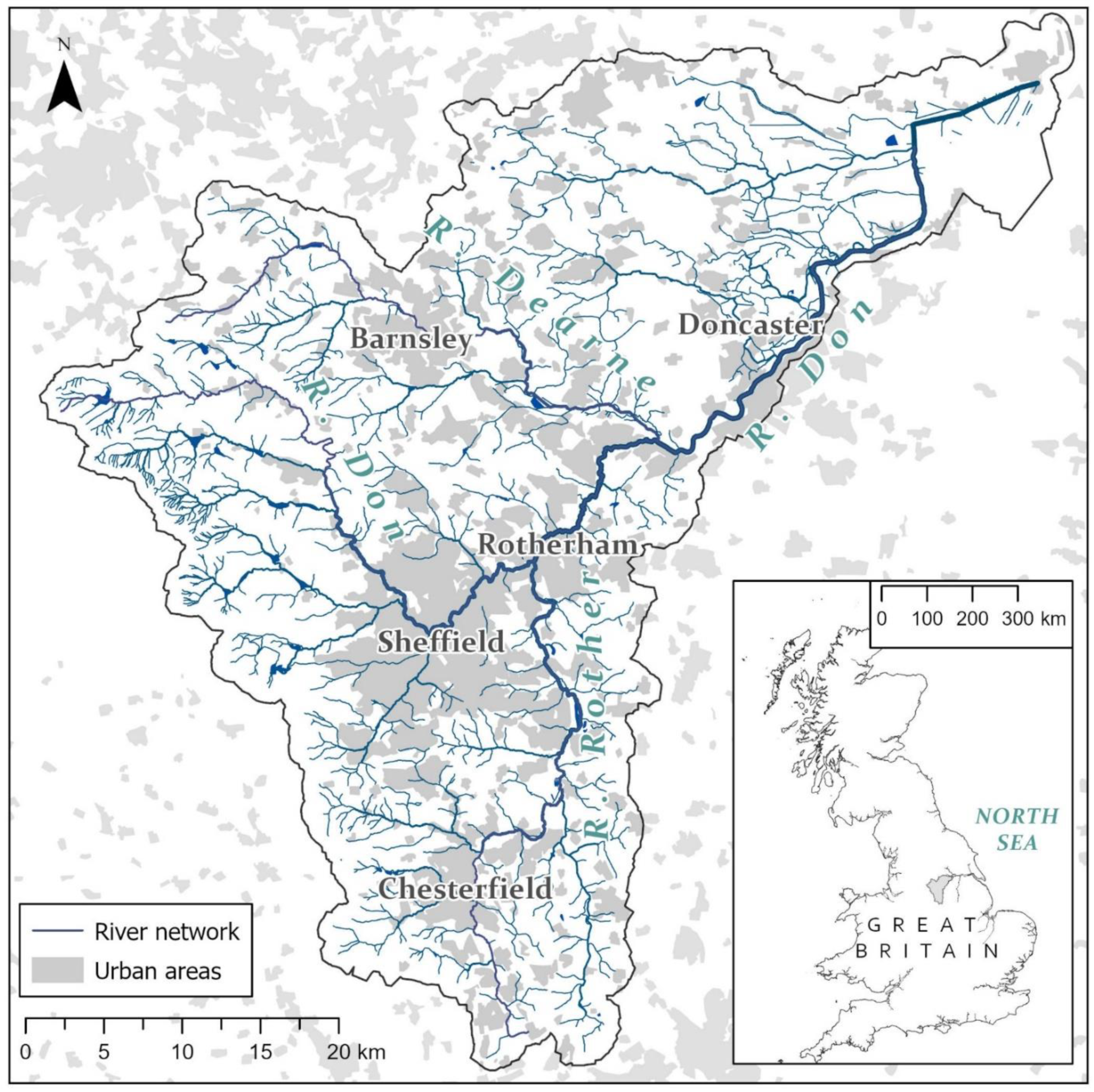
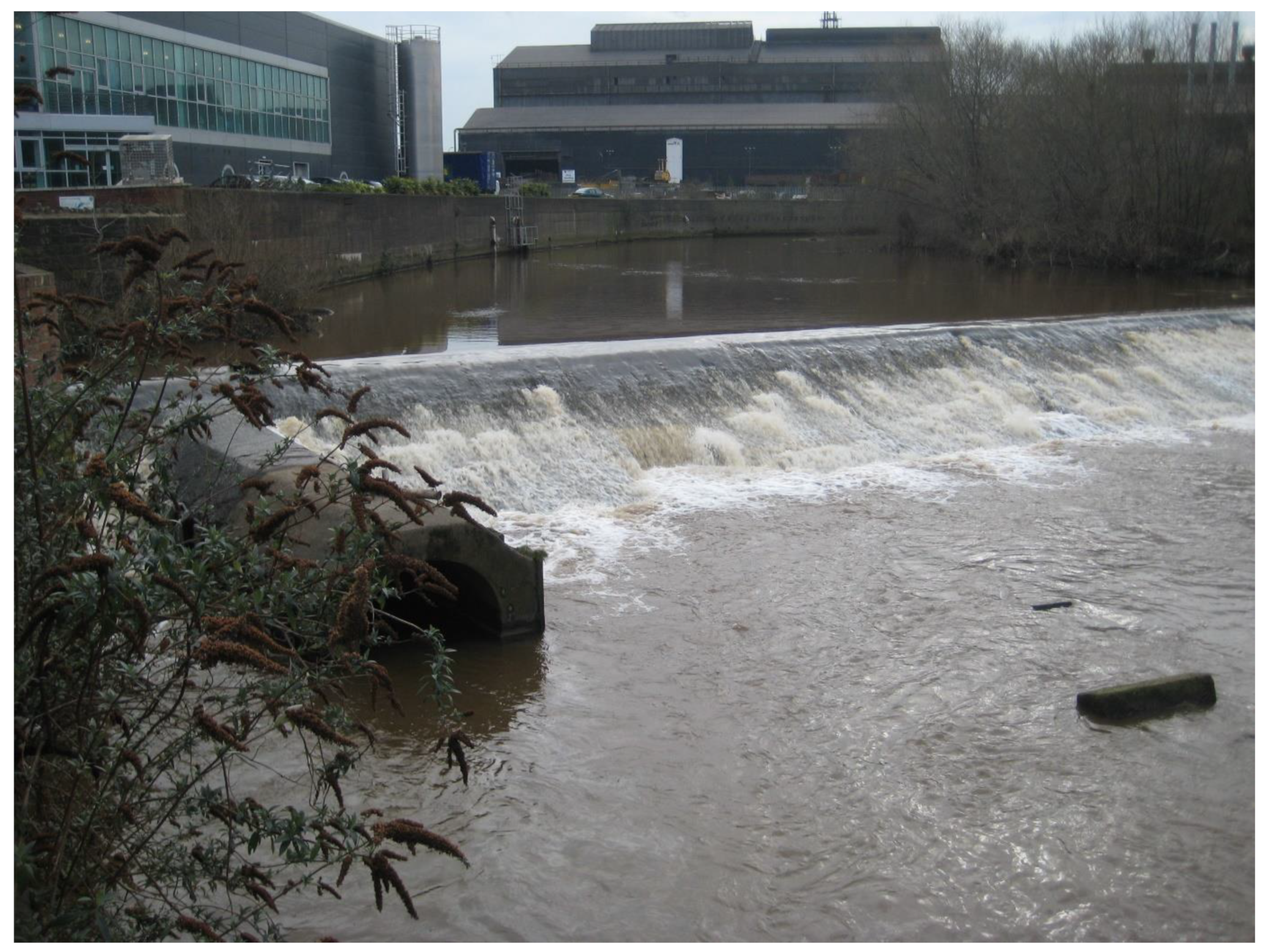
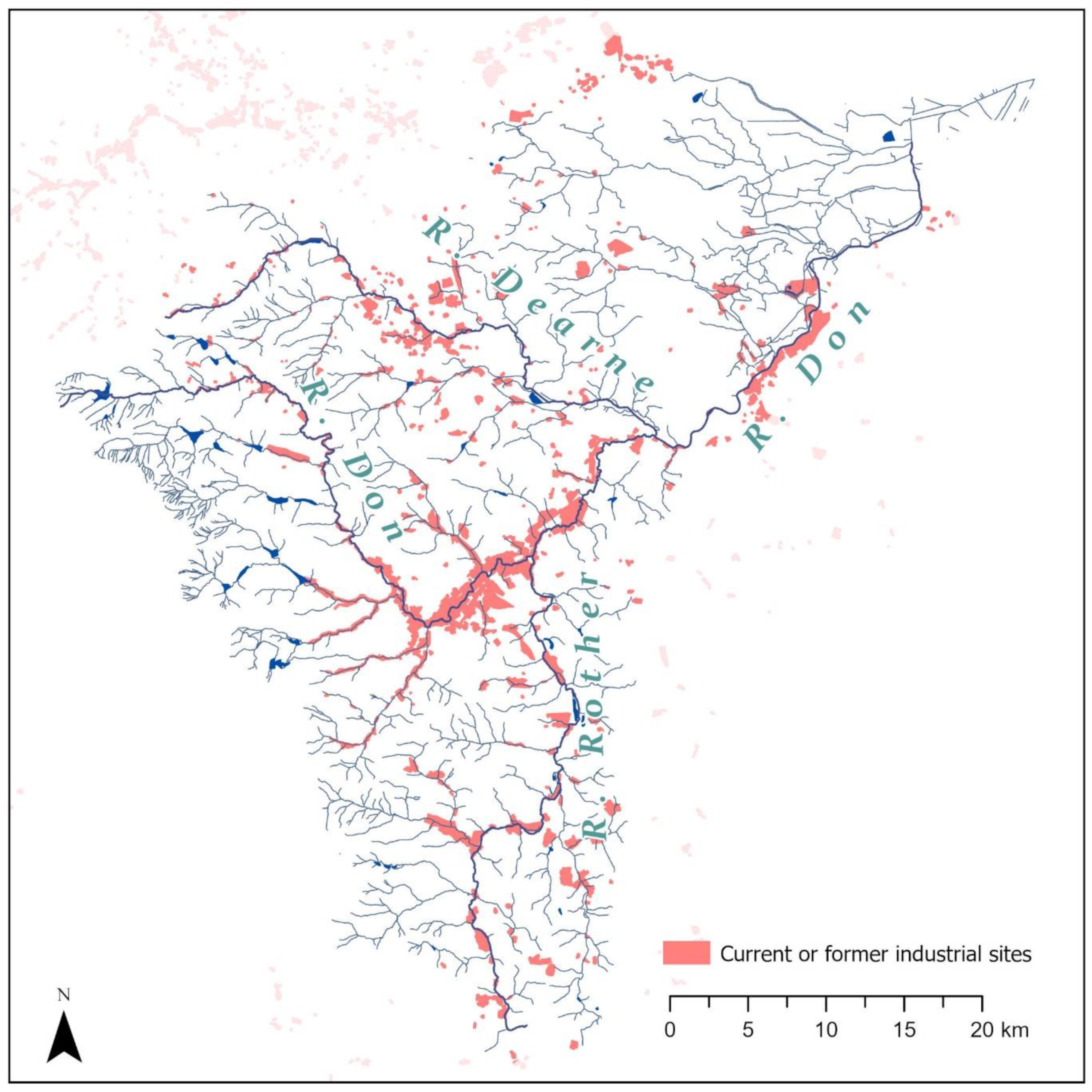
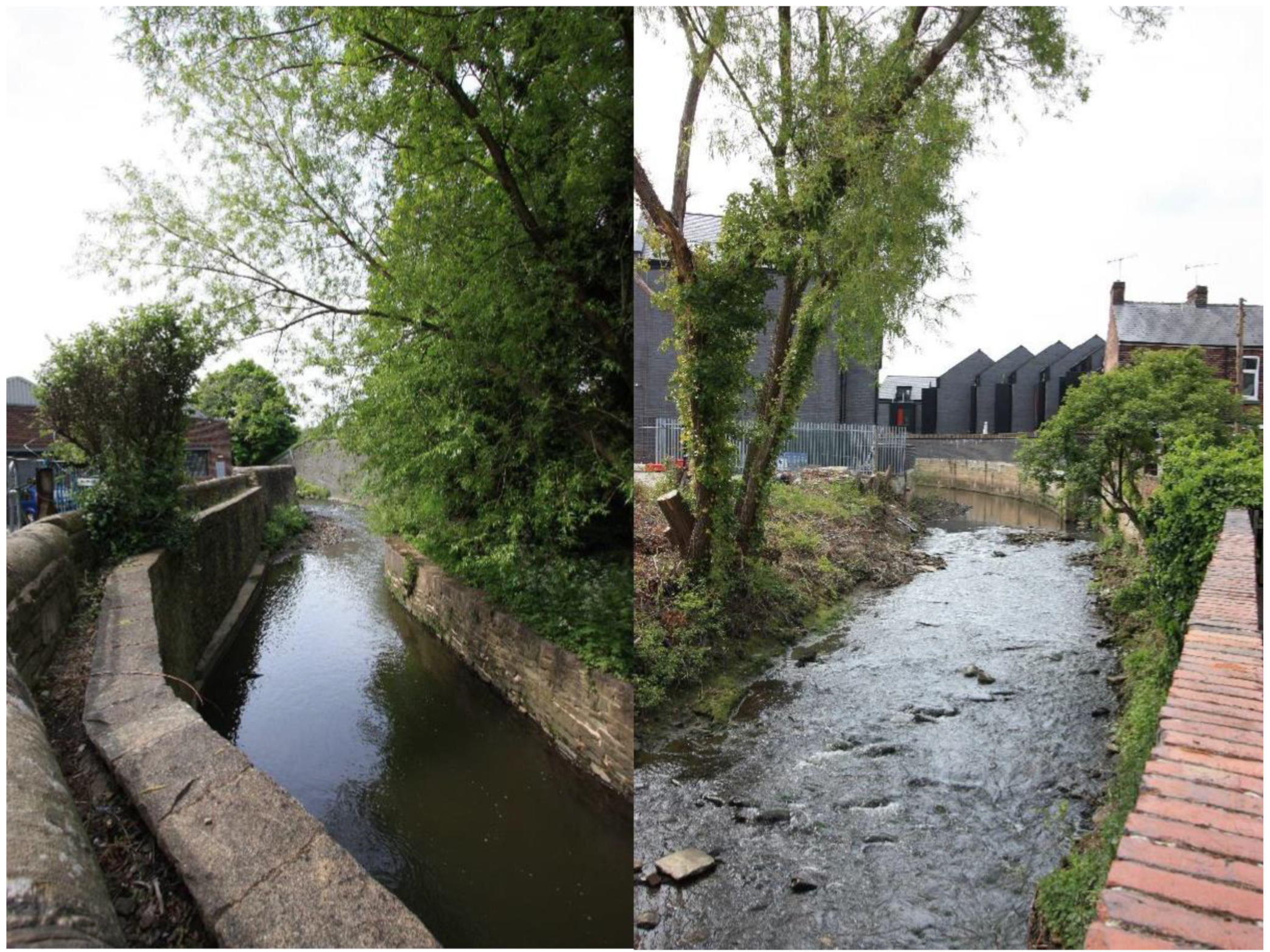
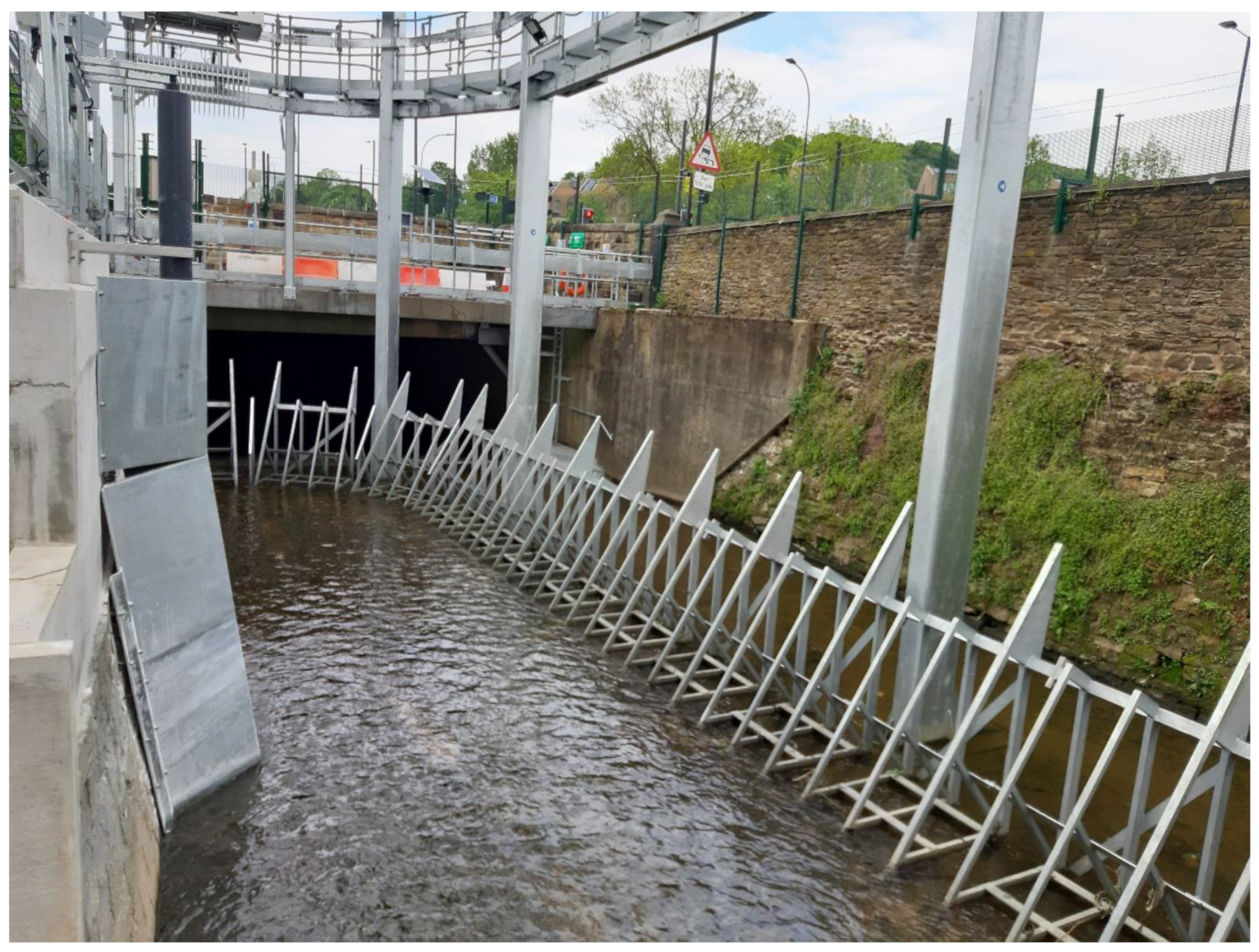
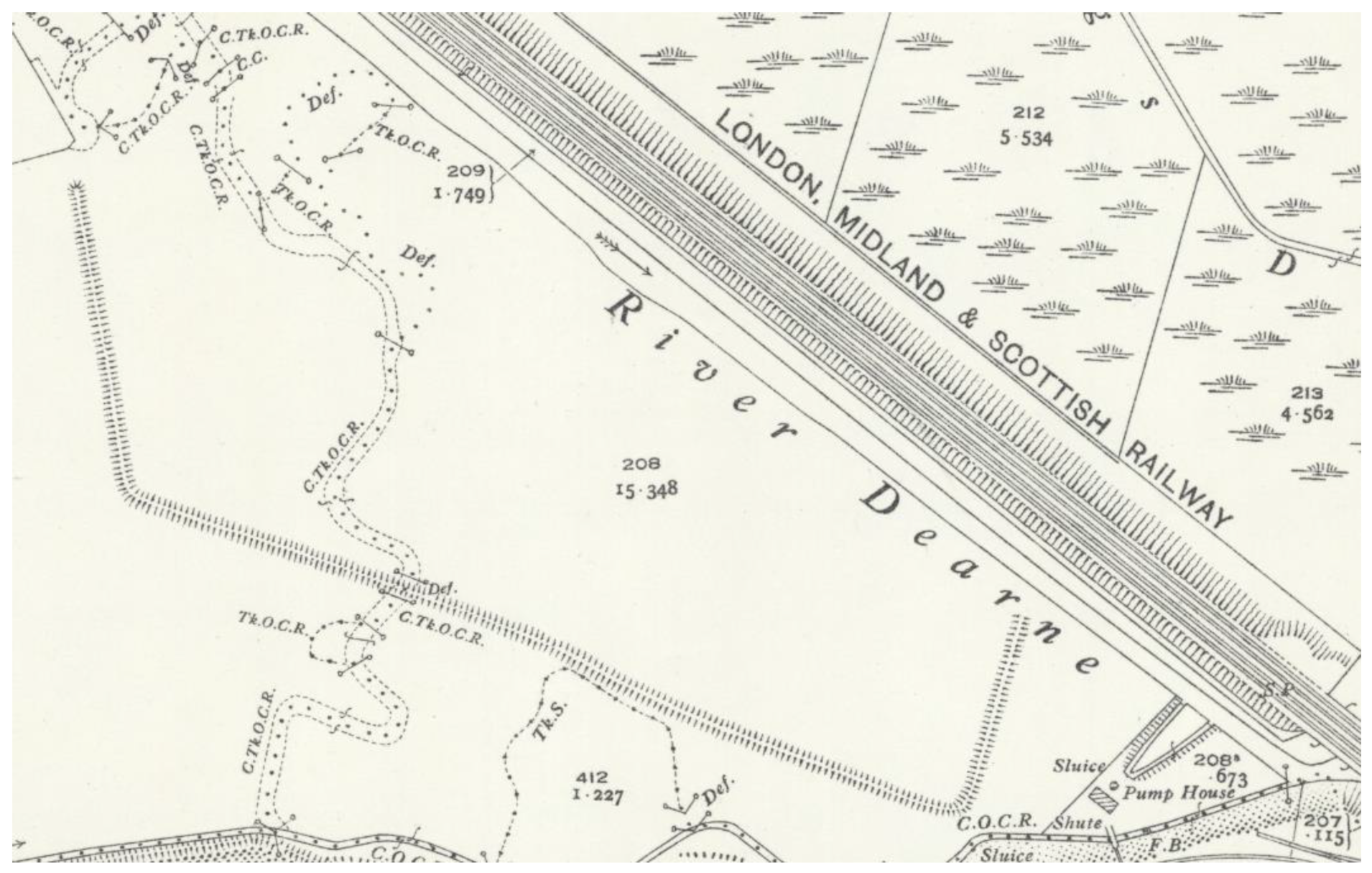
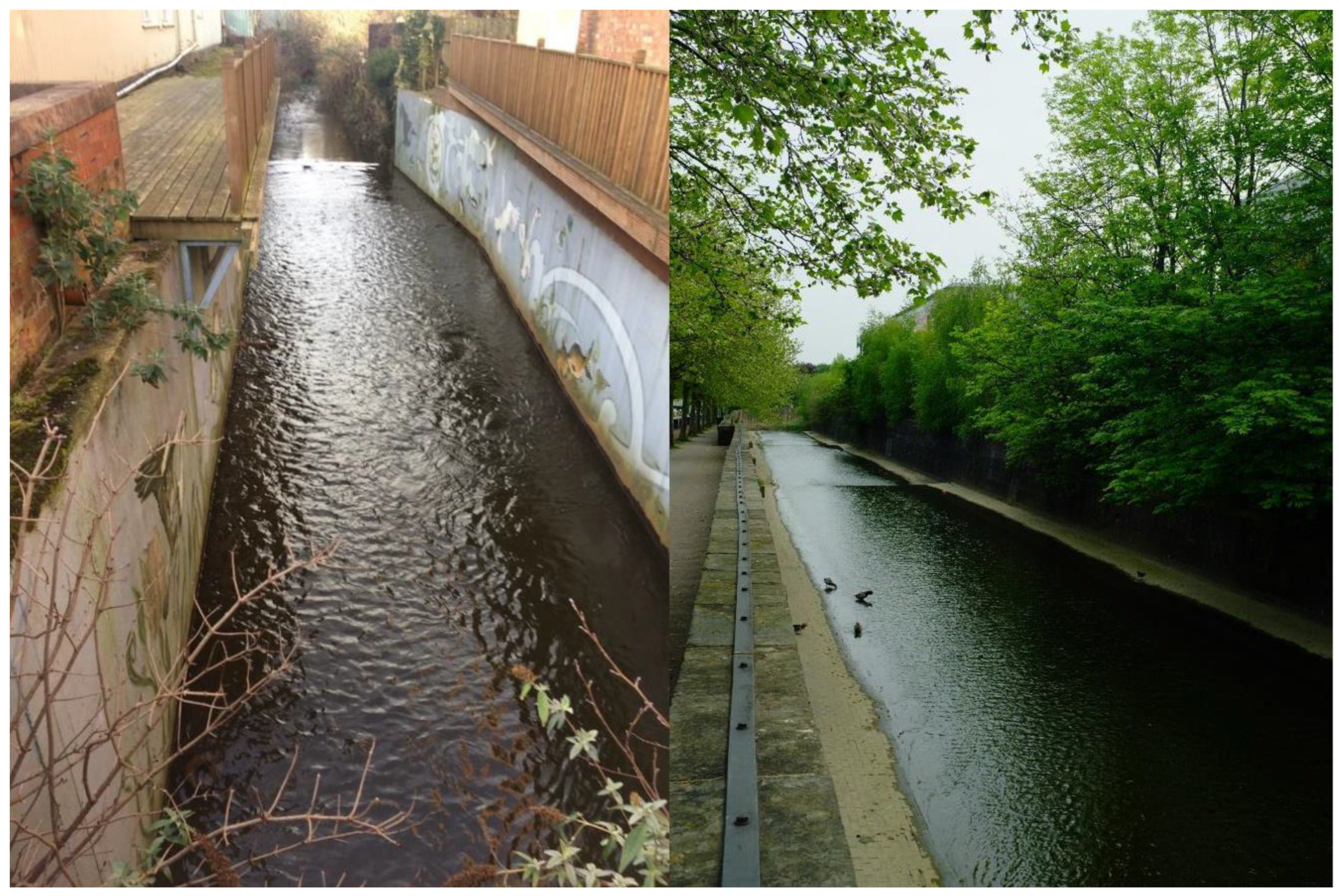
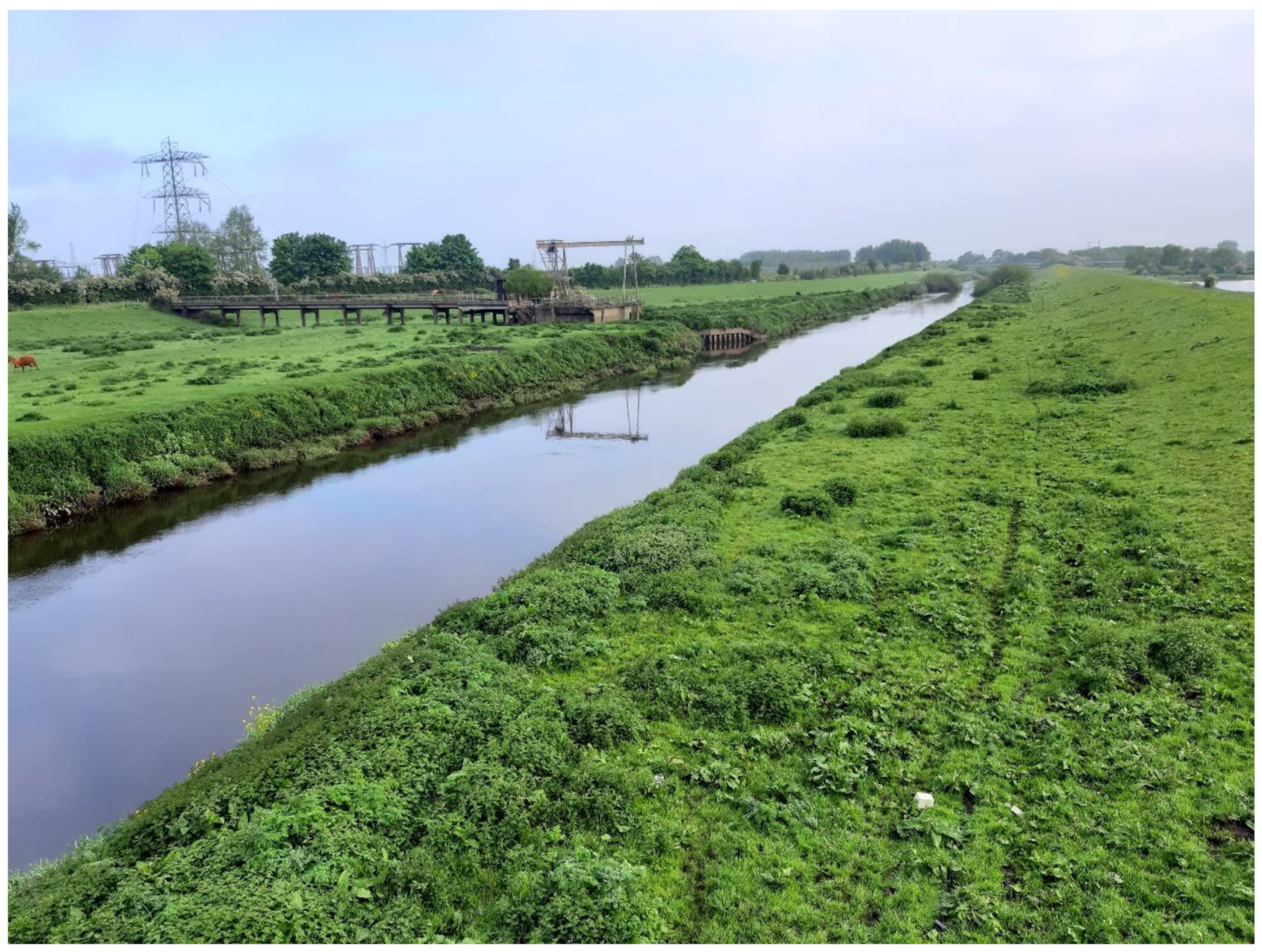
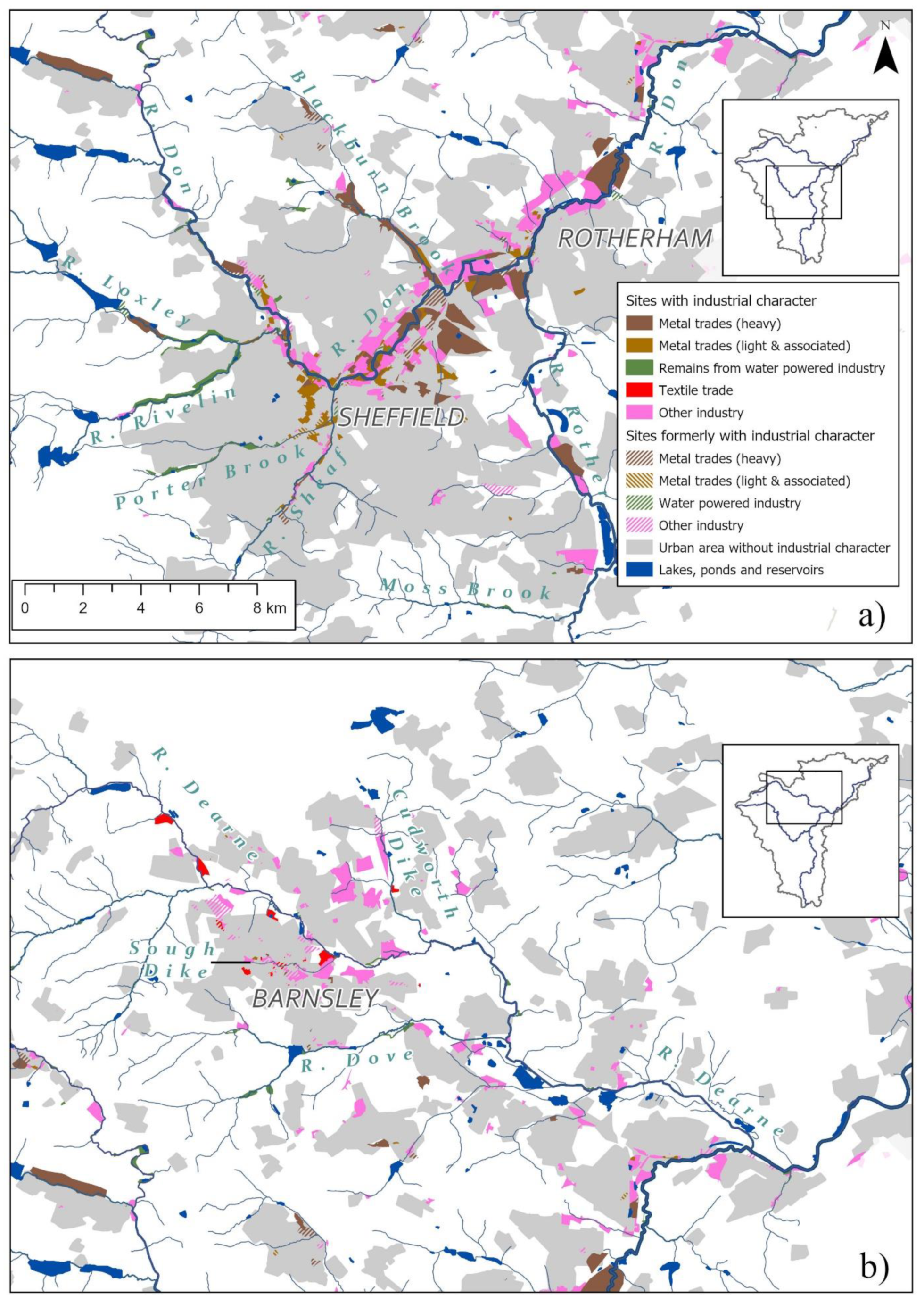
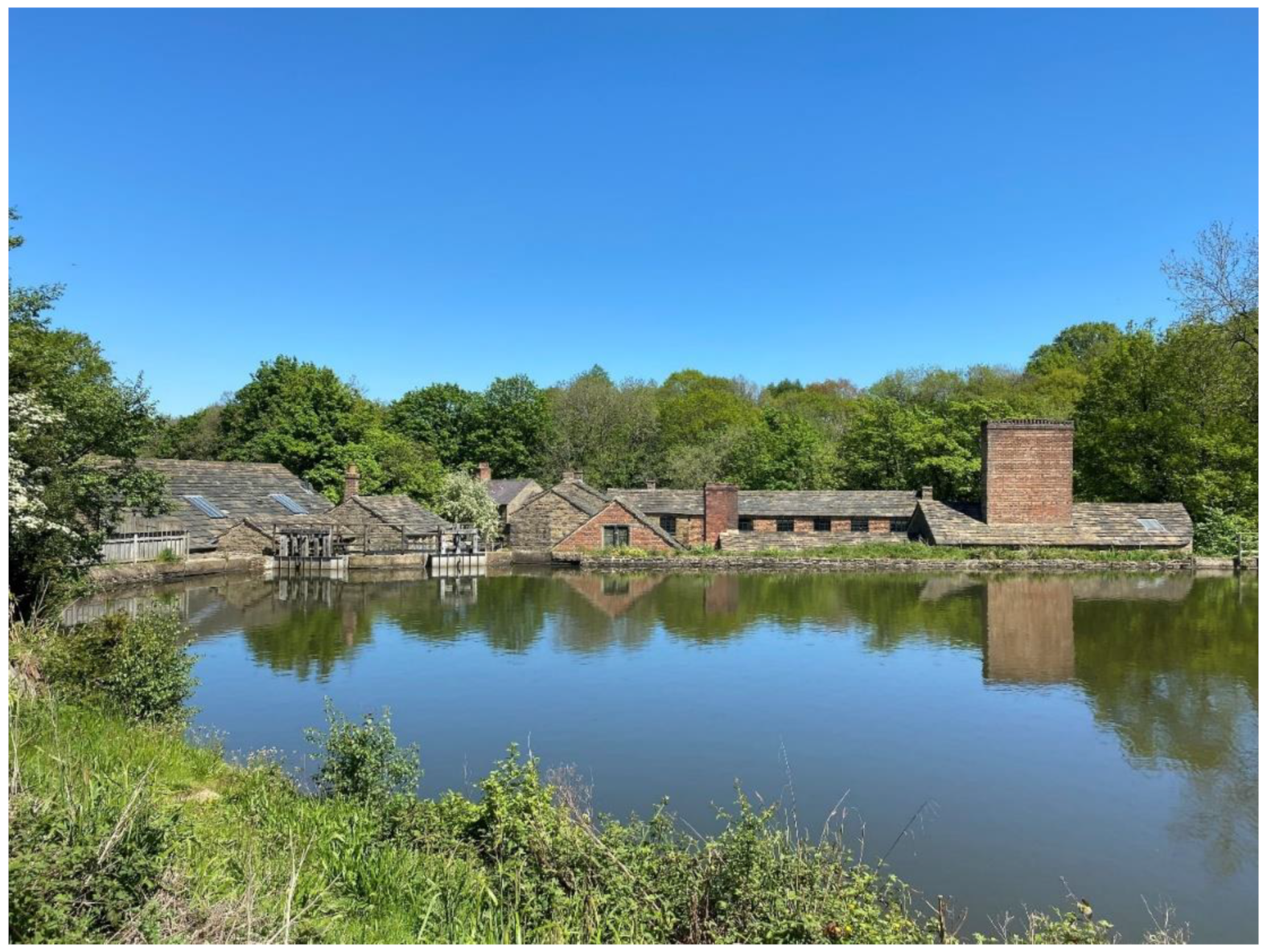
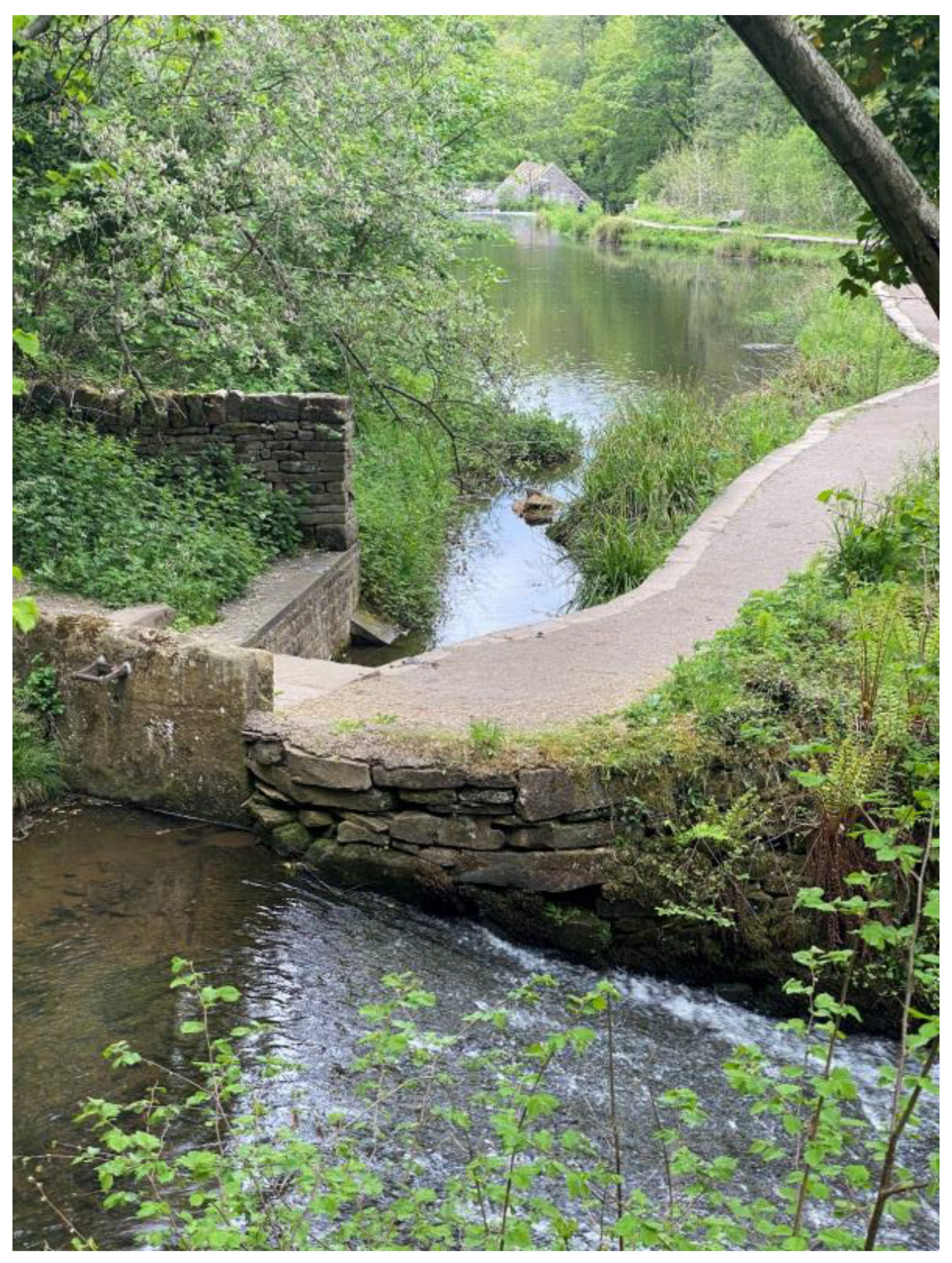
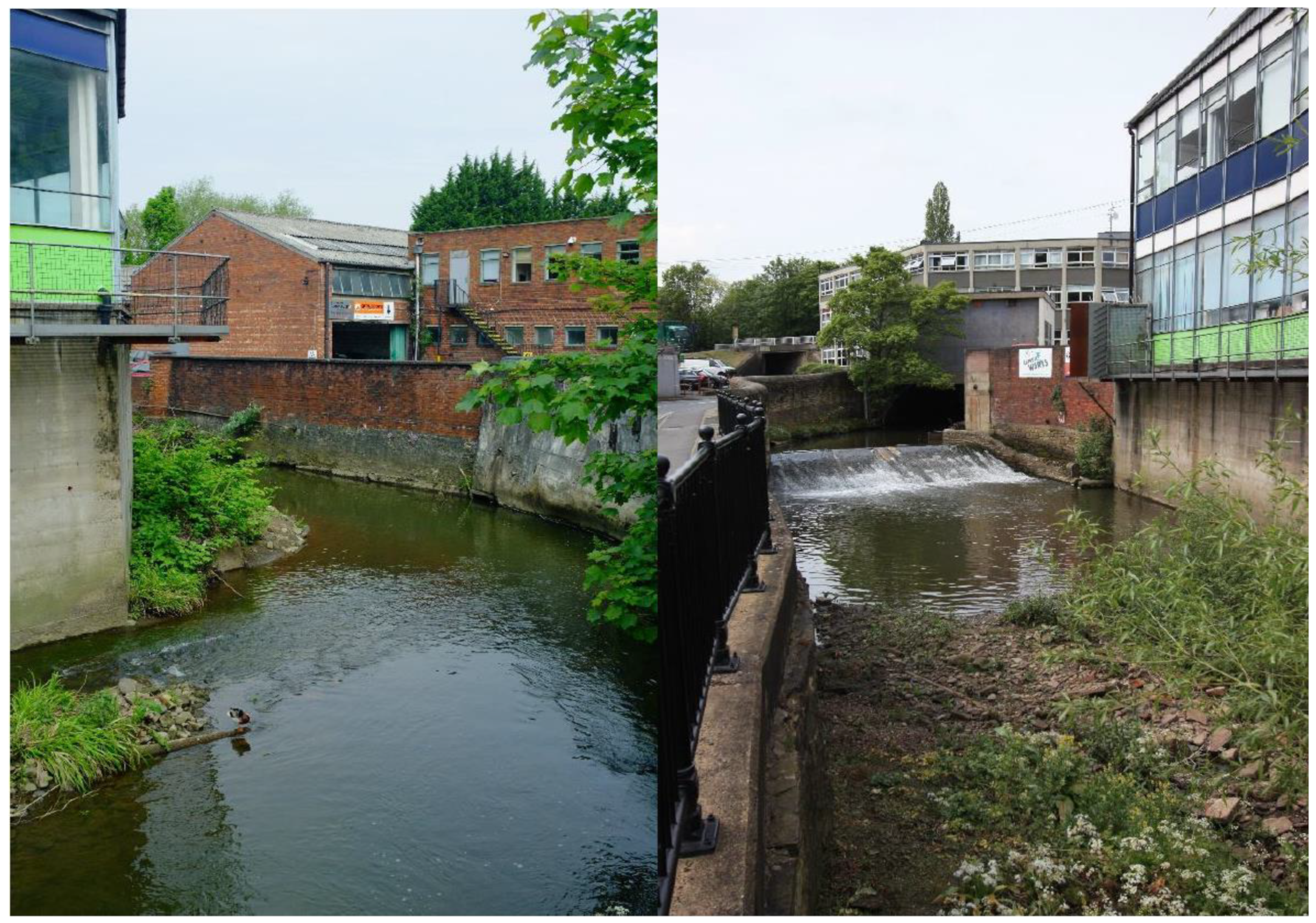

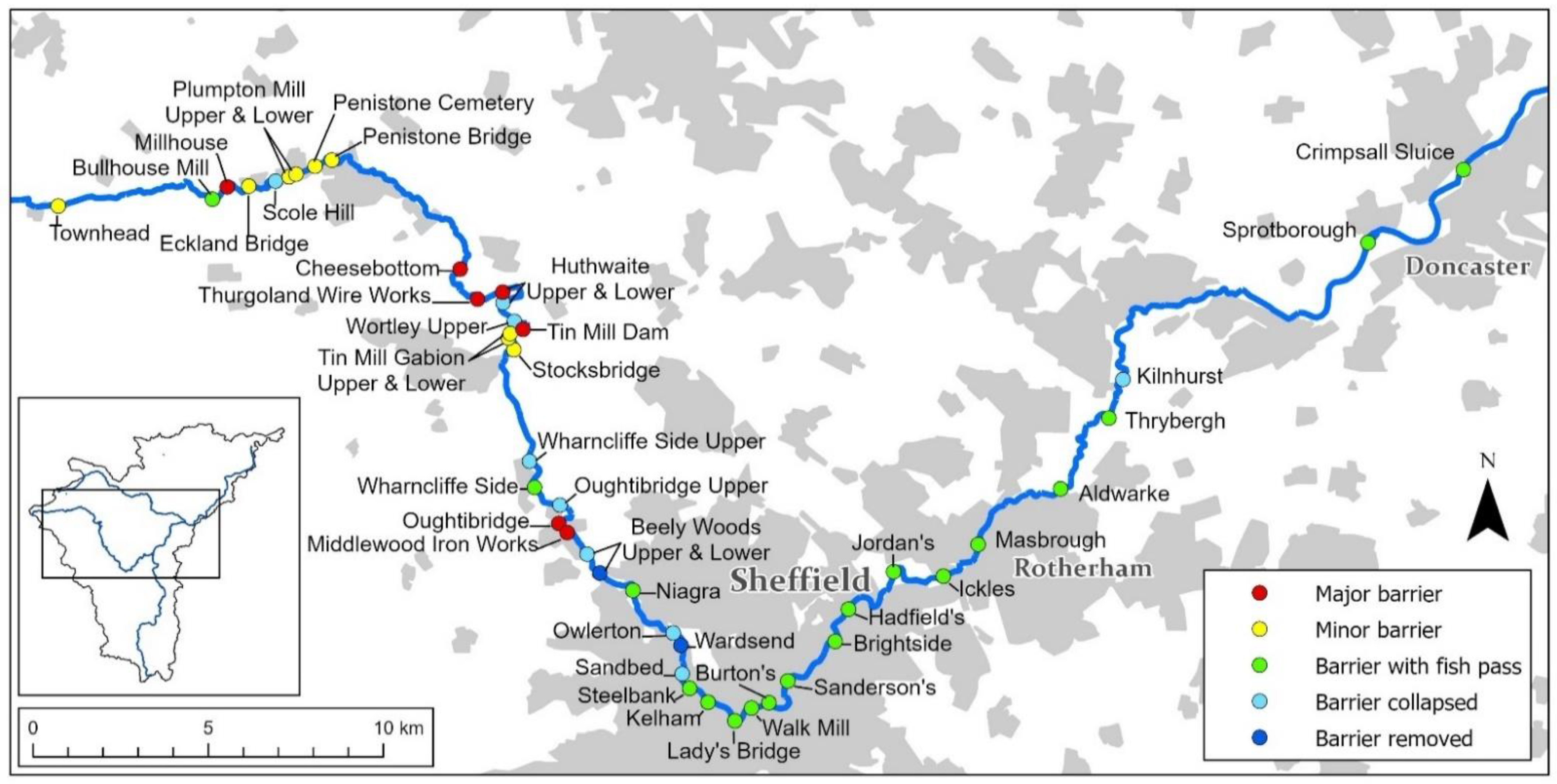
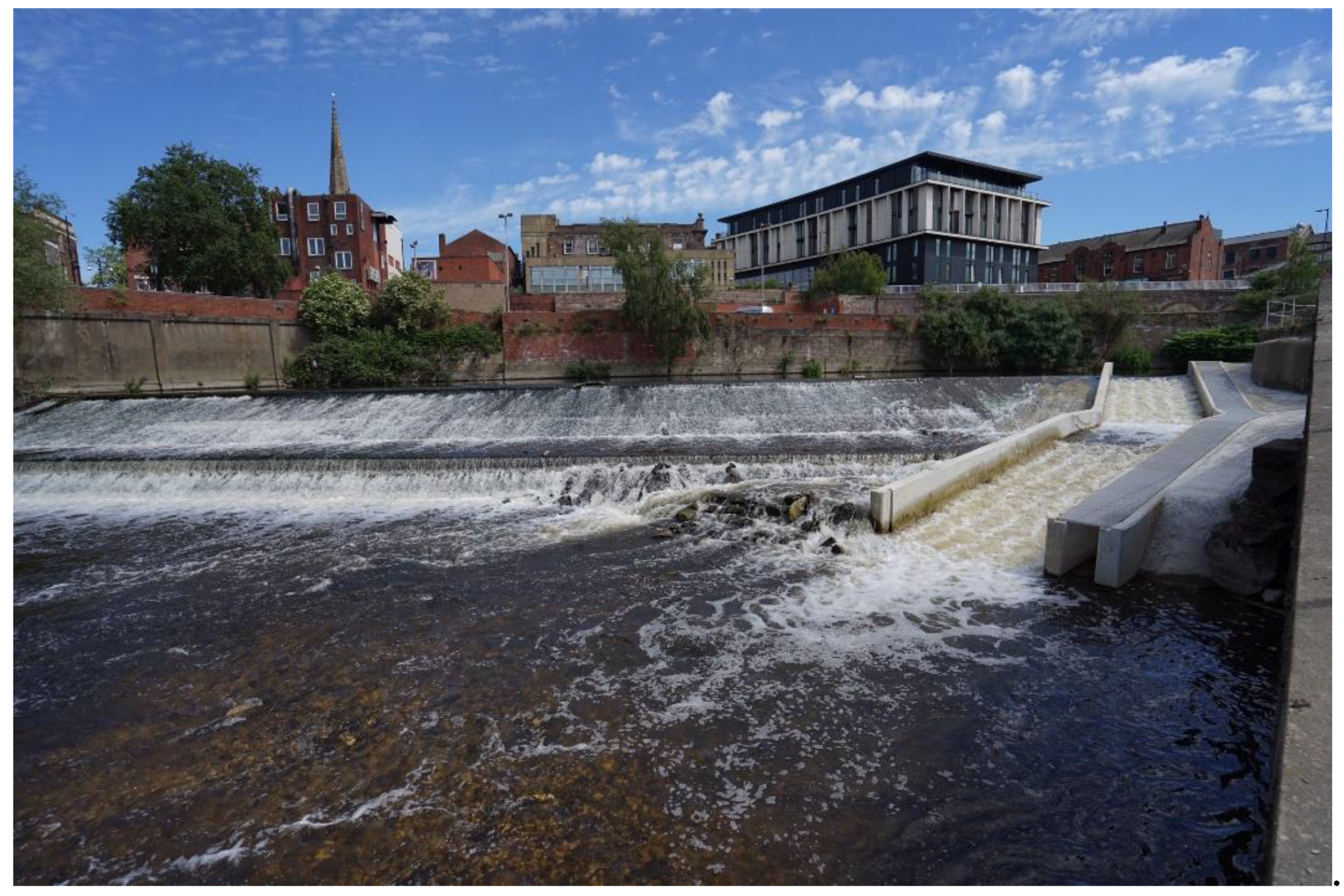
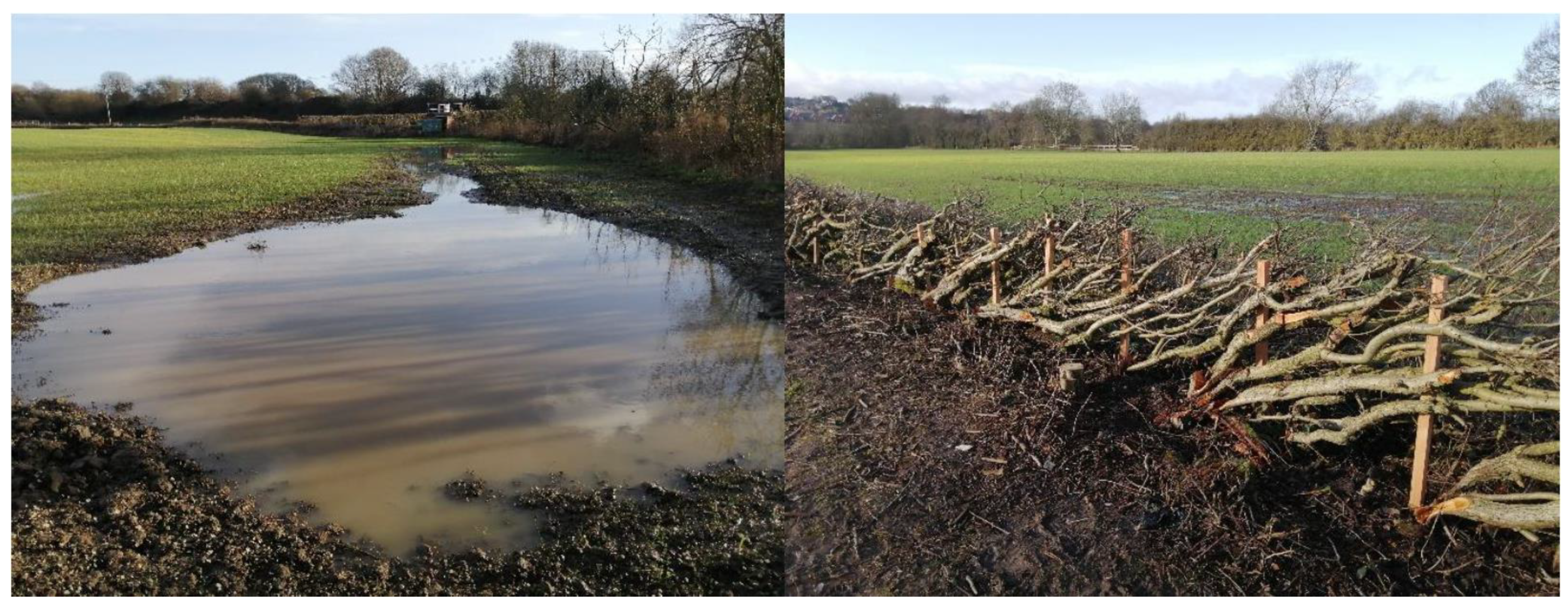

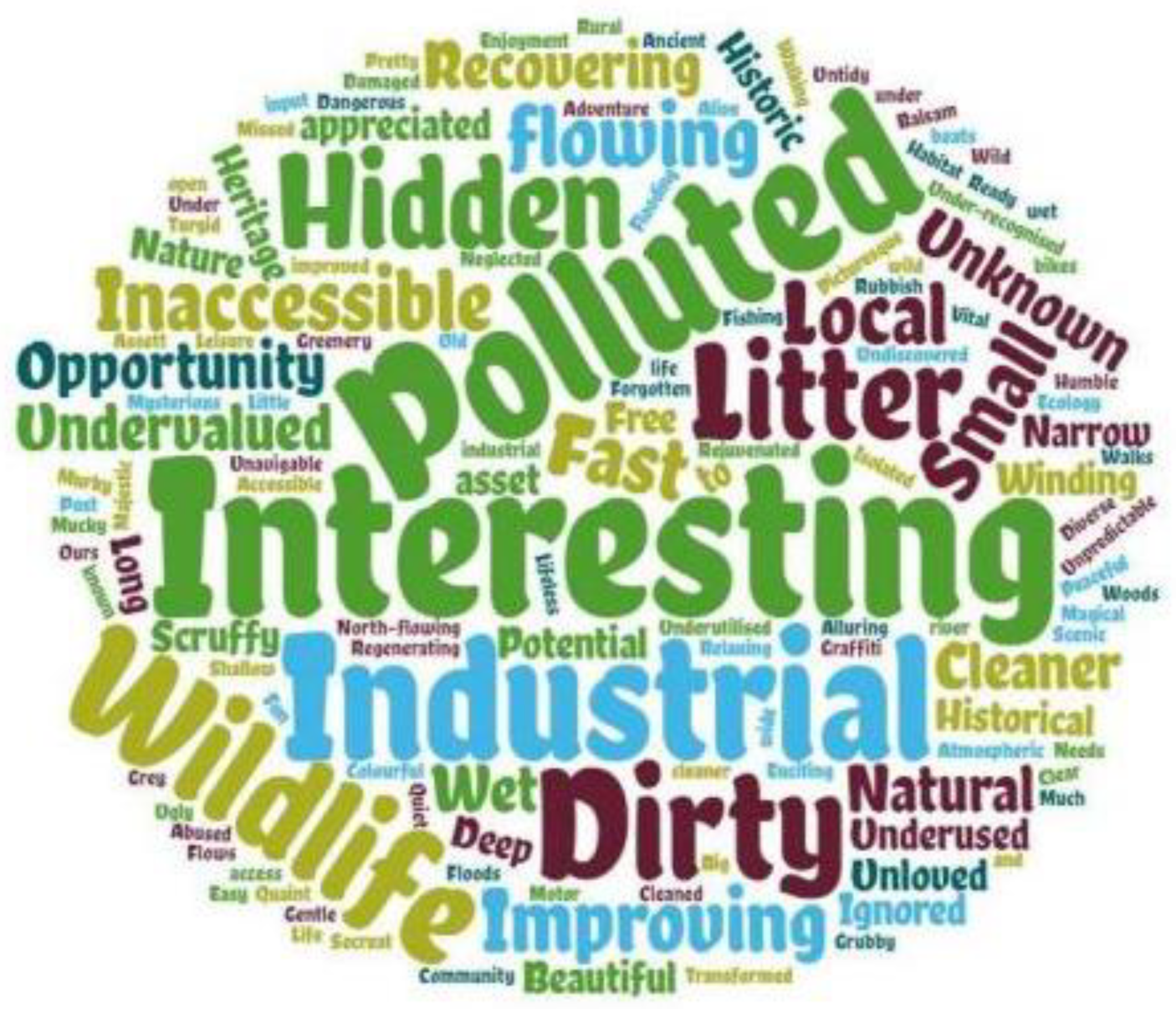
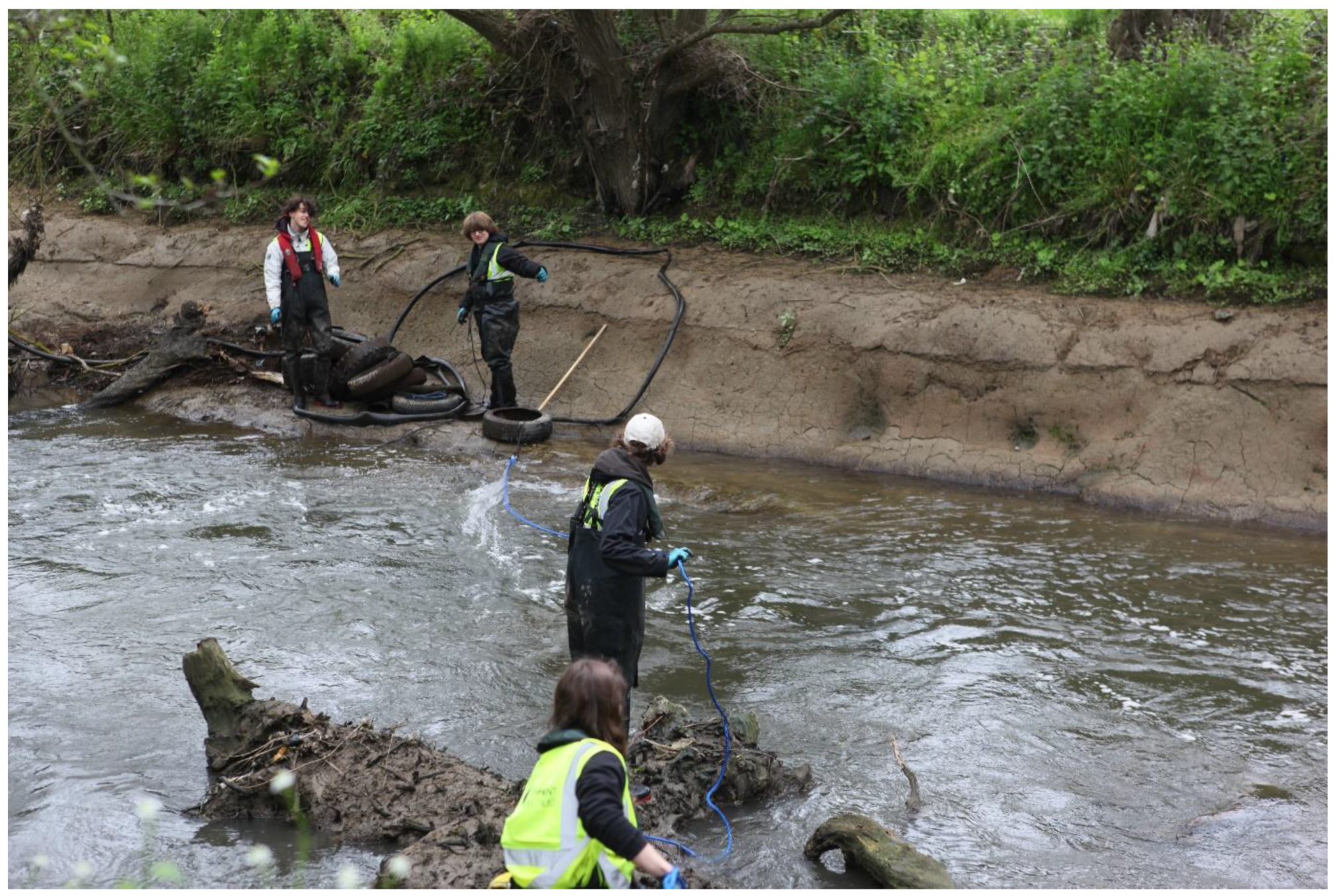
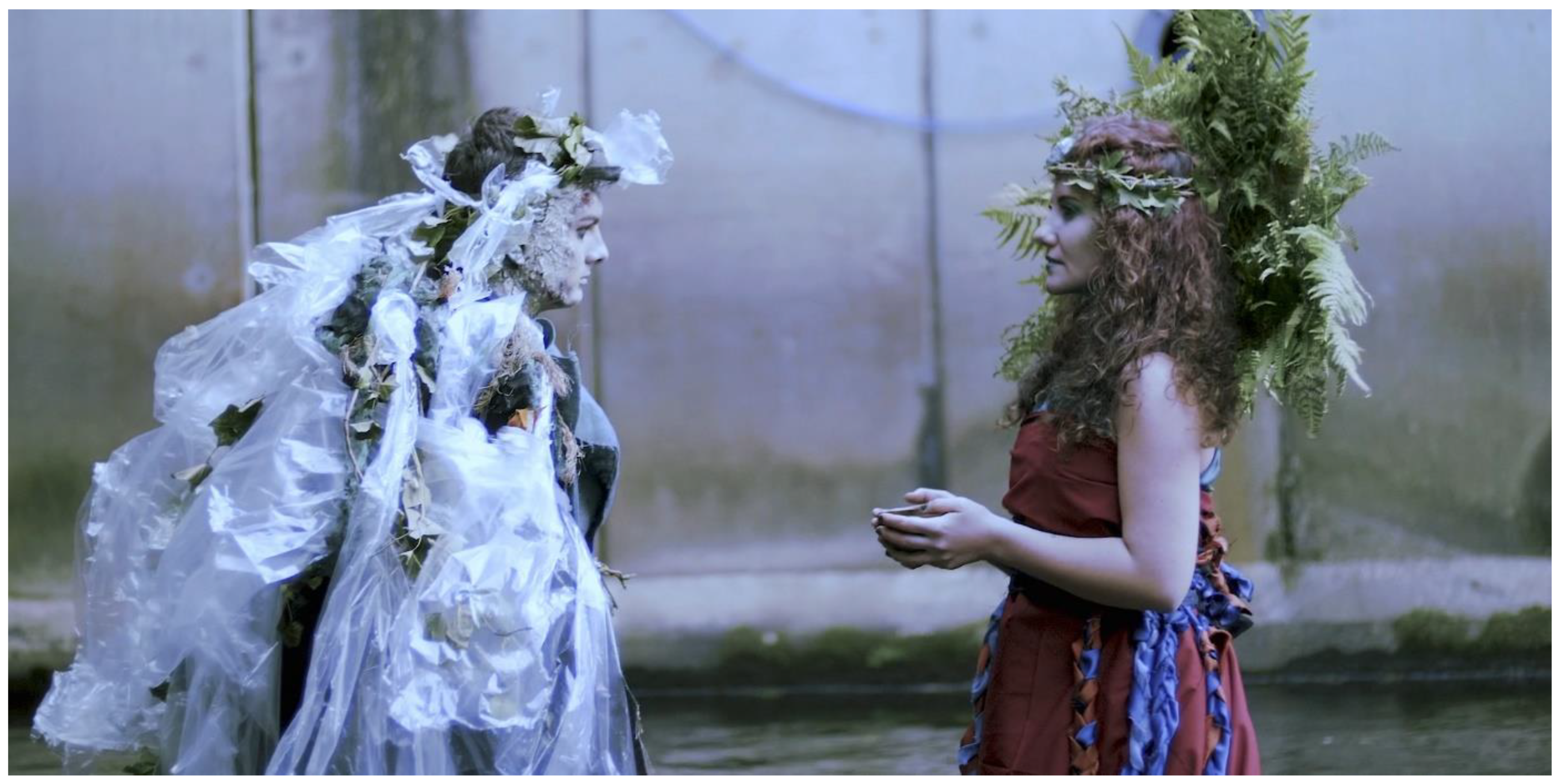
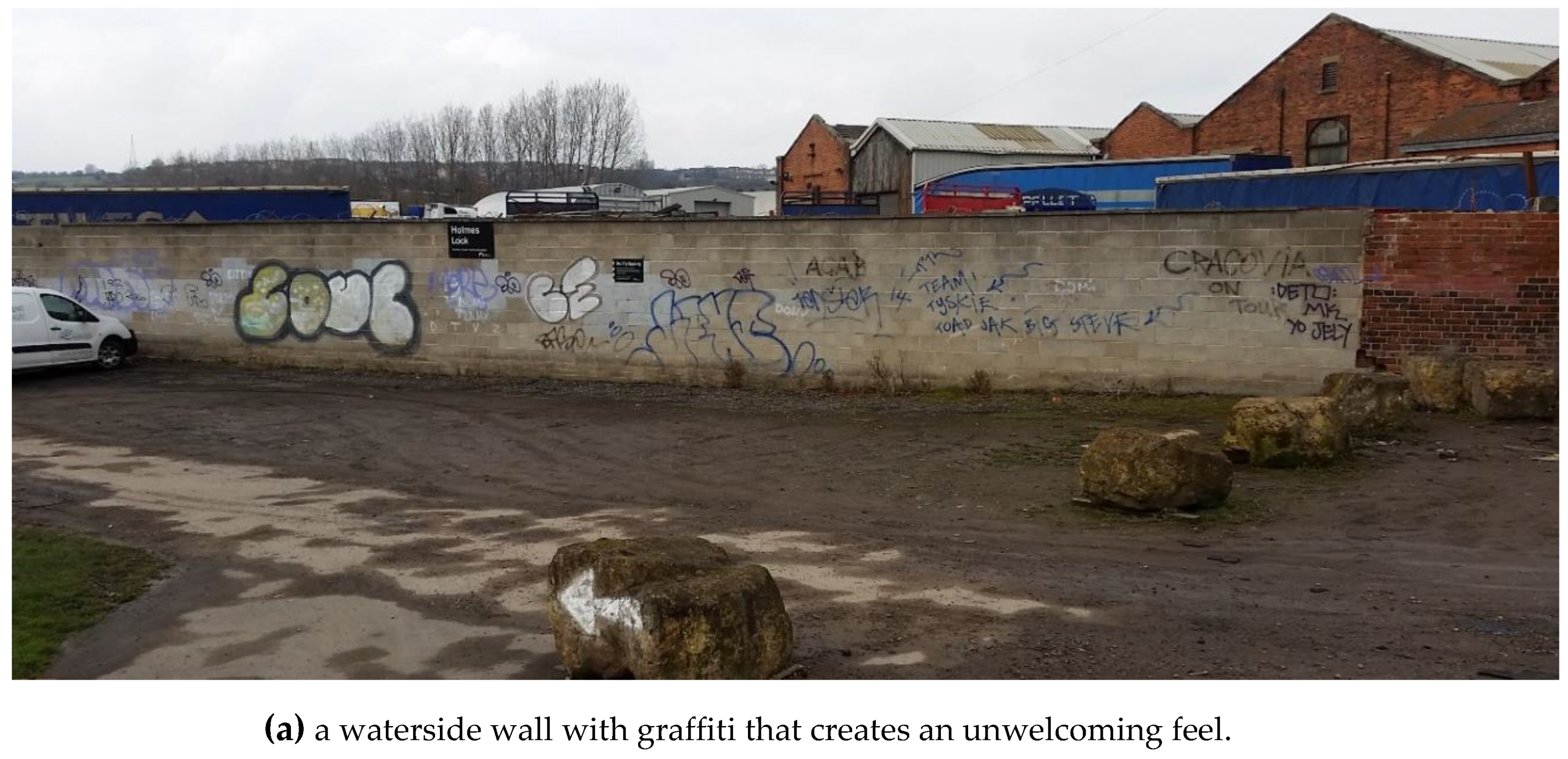
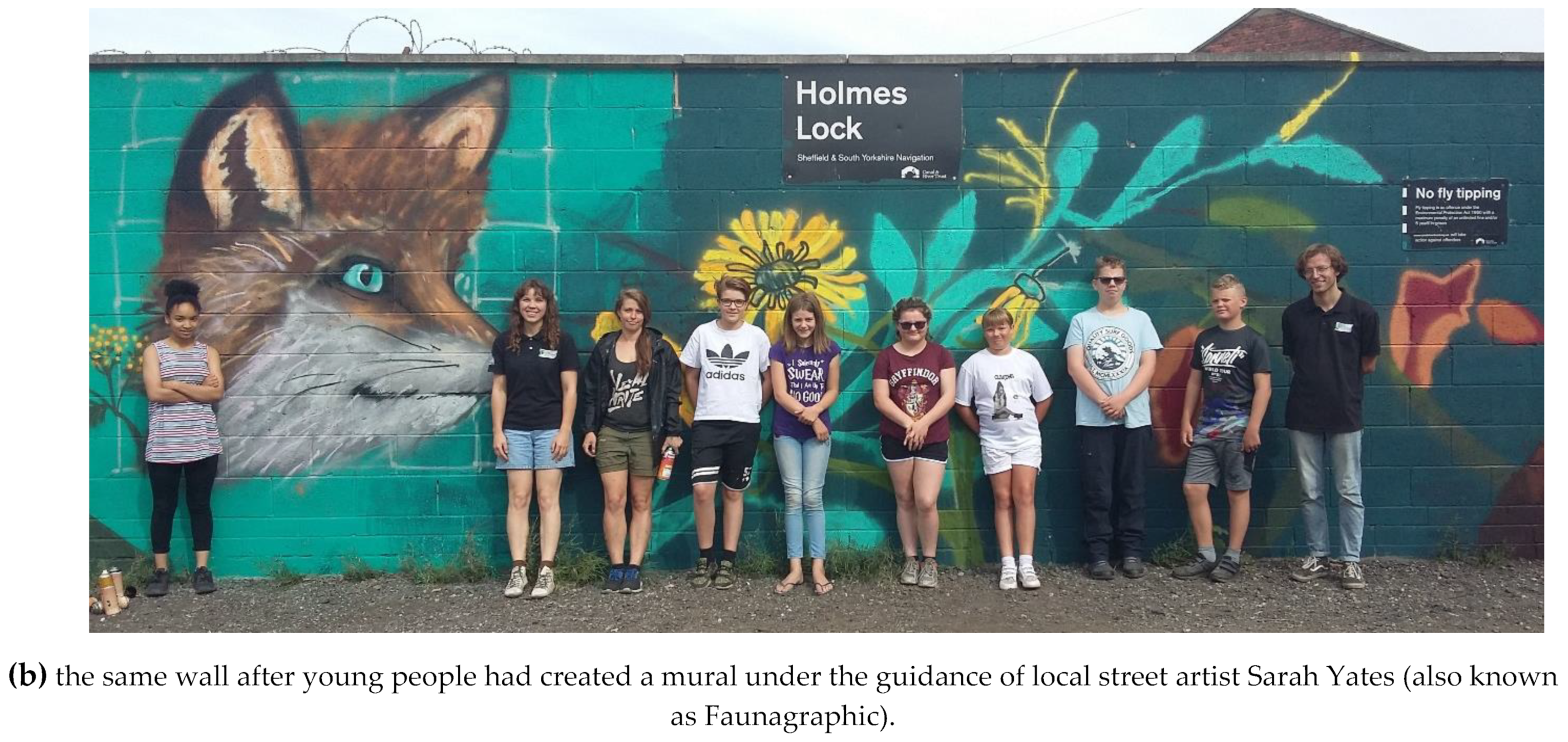
Publisher’s Note: MDPI stays neutral with regard to jurisdictional claims in published maps and institutional affiliations. |
© 2021 by the authors. Licensee MDPI, Basel, Switzerland. This article is an open access article distributed under the terms and conditions of the Creative Commons Attribution (CC BY) license (https://creativecommons.org/licenses/by/4.0/).
Share and Cite
Shaw, E.; Coldwell, D.; Cox, A.; Duffy, M.; Firth, C.; Fulton, B.; Goodship, S.; Hyslop, S.; Rowley, D.; Walker, R.; et al. Urban Rivers Corridors in the Don Catchment, UK: From Ignored, Ignoble and Industrial to Green, Seen and Celebrated. Sustainability 2021, 13, 7646. https://doi.org/10.3390/su13147646
Shaw E, Coldwell D, Cox A, Duffy M, Firth C, Fulton B, Goodship S, Hyslop S, Rowley D, Walker R, et al. Urban Rivers Corridors in the Don Catchment, UK: From Ignored, Ignoble and Industrial to Green, Seen and Celebrated. Sustainability. 2021; 13(14):7646. https://doi.org/10.3390/su13147646
Chicago/Turabian StyleShaw, Ed, Debbie Coldwell, Anthony Cox, Matt Duffy, Chris Firth, Beckie Fulton, Sue Goodship, Sally Hyslop, David Rowley, Rachel Walker, and et al. 2021. "Urban Rivers Corridors in the Don Catchment, UK: From Ignored, Ignoble and Industrial to Green, Seen and Celebrated" Sustainability 13, no. 14: 7646. https://doi.org/10.3390/su13147646
APA StyleShaw, E., Coldwell, D., Cox, A., Duffy, M., Firth, C., Fulton, B., Goodship, S., Hyslop, S., Rowley, D., Walker, R., & Worrall, P. (2021). Urban Rivers Corridors in the Don Catchment, UK: From Ignored, Ignoble and Industrial to Green, Seen and Celebrated. Sustainability, 13(14), 7646. https://doi.org/10.3390/su13147646




